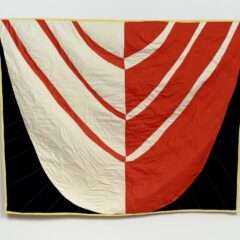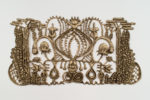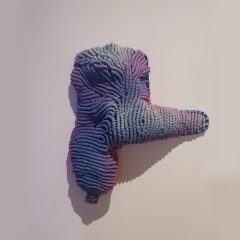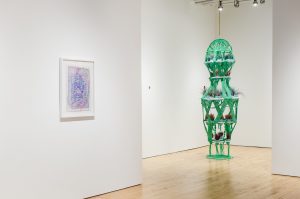This week’s Weekly includes my review of Morgellons, the emerging artist’s show at Fleisher-Ollman Gallery. Below is the copy with some pictures. Here’s the link to the art page. And see more pictures at my flickr.
Bugging Out
“Morgellons” is a beautiful show filled with frustration.
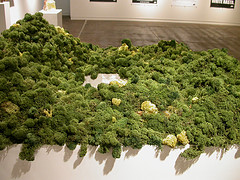
Roxana Perez-Mendez, (detail) Tierra Incognita Asteroide 1,2,3 and Tierra Incognita (La Lamada) 2006 deer moss, audio subwoofer, wood, glass beads, sea shells, led light, swarovski crystal rhinestones, silk florals. This piece, part of which was in her Fleisher Challenge show last year, captures much of the show’s ambiance — its push to decor, its unhappiness with geo and eco politics, its inward-gazing vision.
The CDC is currently investigating morgellons, a possibly fictional contagion that causes all-over body sores, delusions of parasites and insects inside the body, and bizarre colored fibers popping out of the skin.
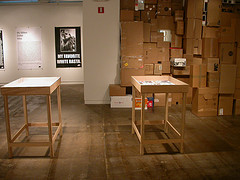
Morgellons, installation shot with Nami Yamamoto’s specimen tables in the foreground, Isaac Lin’s cardboard-box cave, right rear and Jasson Scot Musson’s posterizing. left rear.
The fourth annual emerging artists exhibit at Fleisher/Ollman takes its name from the disease. But what’s real about “Morgellons” (the show) is its ambience of sadness, much of it coated in glitter, braggadocio and a sense of frustration, of humans shouting into the storm.
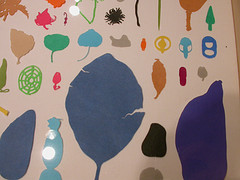
Nami Yamamoto’s Miniature Garden, detail, cut paper silhouettes in candy colors of objects from daily life.
Nami Yamamoto’s Miniature Gardens 1 and 2 are specimen cases with pretty, bright-colored symbols of life laid out in a grid. However, in Yamamoto’s non-taxonomy, a soda can pop-top is twice as big as a hand grenade, which is three times smaller than a paper clip. Fortunately it’s all virtuoso cut paper, and it evokes children playing with paper dolls or collecting and displaying bugs—things kids do to make sense of the world.
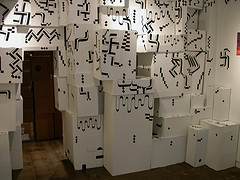
Isaac Lin’s cave emblazoned with signs and signifiers that might represent electronics, communication, contagion, information, game-playing, writing, anointments against evil and joyful graffiti.
Isaac Lin’s cardboard box cave is also a throwback to child’s play. But with its obsessively decorated cave walls it evokes Lascaux, hidden meanings and ancient symbols. Lin’s repeated patterns (on the walls, on paper and on photographs of the sky) look like exploded electronic circuit boards or DNA sequences, or perhaps ur-calligraphy.
The meaning is clear without a Rosetta Stone. You get the urgency. But the feeling of embattlement, of word and object overload and the need to seek shelter, is balanced by the obvious delight in making marks, telling a story and ducking back outside again to experience the brouhaha.
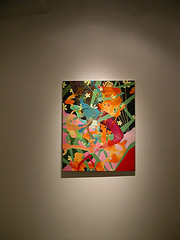
Andrew James, One crazy ass June, 2006. oil on canvas. 40 x 32″. James’s modest-scale paintings with their built up surfaces embrace abstraction, representation, decor, beauty and ugliness — the whole of life.
“Morgellons” has beauty in abundance. Andrew James’ trio of oil paintings with swooshy abstraction punctuated by descriptive elements (a row of pine trees, for example) is exciting and feels new.
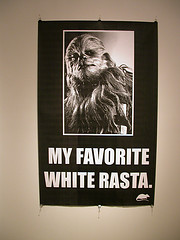
Jayson Scott Musson’s poster, focused on the experience of being black in an overwhelmingly white art world.
Jayson Scott Musson’s storytelling posters (seen at his recent solo show at Space 1026) are rants about being black in a white world, and the works are standup comedy rich. Their beauty, like their truth, lies on the surface as well as beneath.
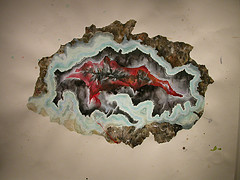
Casey Watson’s carnivorous-looking agate, in ink on paper.
Elena Drozdova’s melted and interlocked bottles and jars are sex without comfort. Casey Watson’s works on paper (a decorated skull, an overripe agate) are decor with teeth.
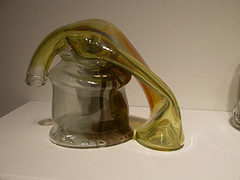
Elena Drozdova’s too-pooped-to-pop glass bottles embody sexual ennui or fatigue.
Andrew Suggs’ works with cut fabric, threads, condoms and painted Rolling Stones album covers are tarted-up and taunting, while Michael Sirianni’s digital prints of male fashion models in beautiful house settings are ludicrous and unfashionable.
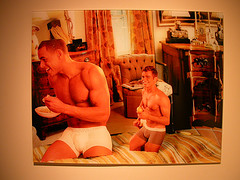
Michael Sirianni, untitled i, 2005. face-mounted inkjet print 30 x 40″

Lee Arnold’s S-Bahn. The piece is projected large and happily there are chairs for viewers to sit on. The piece is short and loops in a waltz-like way, speeding up and slowing down and seemingly repeating forever.
It’s Lee Arnold’s minor key soundtrack for his dreamy video projection S-Bahn that seems to have the last word. The thrumming audio washes over the entire gallery and colors the show in a kind of slow merry-go-round ambience that suggests life repeating itself, with very little learned along the way.
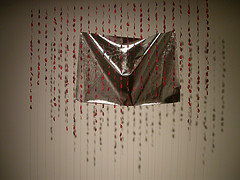
Andrew Suggs’ Paisley View. 2006, cut vintage clothing, metallic fabric,thread, aluminum rod. Something about this piece’s gothic and obsessive vision stopped me cold. In it’s marriage of the victorian and the goth it becomes a monument to our contemporary moment of decadence.
Other artists and curators will tell a different story about our multifaceted world. The particular story “Morgellons” tells reflects reality in this cohort’s eyes. I look forward to another version, since truly there are many more.
“Morgellons”
Through Jan. 20. Fleisher-Ollman Gallery, 1616 Walnut St. 215.545.7562.


